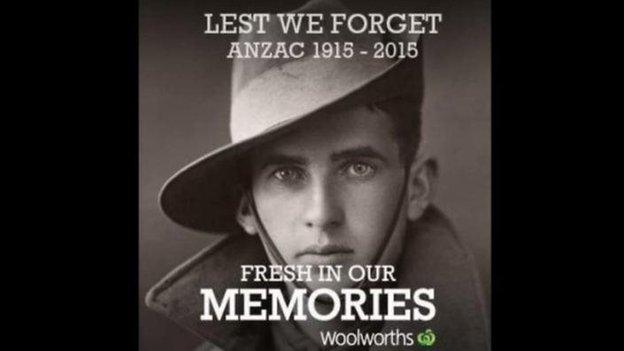Australia commemorations risk loving Gallipoli to death
- Published
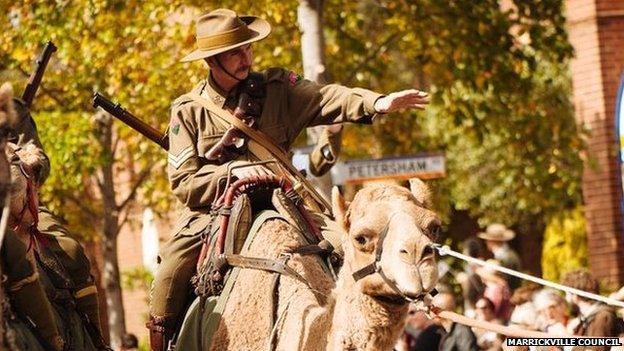
The Sydney suburb of Marrickville remembers WW1 with a camel cavalry down its main street
Last Sunday morning, the multicultural Sydney suburb of Marrickville was transported back in time 100 years.
Camel and Light Horse cavalry filled a main street emptied of cars, and men in uniform marched to the town hall, while local residents stood on the footpaths waving them on.
The parade - which included local bands, choirs and school children - was in memory of the 6,500 local men who enlisted to fight on foreign shores in World War One. A new WW1 memorial was commissioned, an exhibition about the war was staged at the local library - even a special edition Winged Victory beer went on sale at a local brewer.
"There has been an enormous amount of preparation for this event over the past two years," Marrickville Mayor Mark Gardiner told the BBC, explaining that a third of the local men who enlisted in WW1 were killed or wounded.
Ceremonies like this one have been repeated across Australia to mark the centenary of the landing of Australian and New Zealand Army Corps (Anzacs) on the Turkish shores of Gallipoli on 25 April, 1915.
Anzac Day is arguably Australia's most important national occasion. Every year, Australians commemorate the anniversary of that first campaign, and at the same time commemorate all the military conflicts that followed.
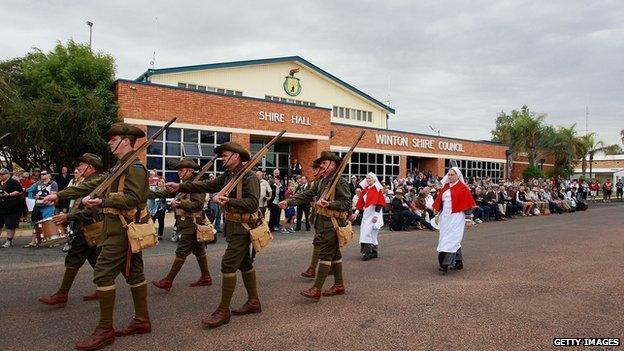
Small towns across Australia like Winton in Queensland remember WW1 with parades
But it is Gallipoli that holds a special place in Australian hearts. Many believe it was here Australians proved themselves the equal of any in the world, heralding the young nation's emergence onto the world stage.
Dawn vigils are held everywhere from the smallest country town to the nation's capital. Later in the day, there are military parades while the afternoons are traditionally given over to drinking and playing the gambling game of two-up.
But this year is different. The Australian government is spending A$145m ($113m, £76m) on Anzac commemorations including building an Australian Remembrance Trail on the Western Front, refurbishing the Australian War Memorial and building a new Australian War Memorial in New Zealand. It has also organised a much bigger-than-usual service at Gallipoli itself, involving 10,500 people. Another A$17m has been donated by the public.
That compares with the £50m being spent by the UK government on WW1 commemorations.
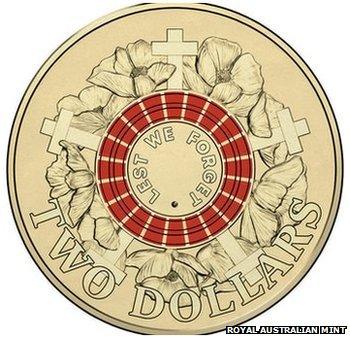
The Australian Mint has issued a special Red Poppy centenary coin
Almost no sector of Australia is untouched by Gallipoli. Cultural institutions have commissioned plays, music and art; there are six television dramas about Gallipoli; a raft of new books, and a commemorative Red Poppy $2 coin issued by the national mint.
In Canberra, the Australian War Memorial expects 50,000 people to attend its Dawn Service on Saturday and the entire commemoration culminates with the services in Turkey where the prime ministers of New Zealand and Australia will be joined by Prince Charles and Prince Harry.
But the commemoration is not without its critics. Some historians have warned of "Anzac fatigue". Others have suggested the people making the pilgrimage to Turkey to the crumbling Dardanelles cliffs risk literally loving Gallipoli to death.
'Military Halloween'
University of Melbourne historian Marilyn Lake says Australia needs to recognise the multiple stories tied up with its WW1 participation such as what it means for women, for Australia's Turkish community and its Indigenous people, including Aboriginal soldiers.
"If we let go the image of the [Australian soldier], what is left?" she said at a recent BBC-British Council event held in Sydney.
Lowy Institute analyst and former soldier James Brown, who has written a book about Anzac commemorations, says they have become akin to a festival of the dead or a "military Halloween". He notes that Australia is spending far more money on Anzac Day ceremonies over the next four years than it spends on treating the mental health of soldiers returning from war.
Concern about the commercialisation of Gallipoli hit the headlines last week when Australia's largest retailer Woolworths was attacked on social media after it launched an advertising campaign that appeared to cash in on the centenary.
Another local retailer, Target, was forced to withdraw three Gallipoli-themed products - a beanie hat, a hoodie and a can holder advertising Anzac Day - after the government deemed them inappropriate.

Service medals and memorabilia of Anzac veterans are precious to their descendants
But every year, the stories of mateship and hardship experienced by Australians at Gallipoli prove more powerful for many Australians than concerns about commercialisation or the dangers of mythologizing war.
At 85, Sydney resident Diana Moore, with her sisters and daughter, has made the long pilgrimage to Gallipoli. Her father Geoffrey Leslie, was among the first to land on Gallipoli 100 years ago. As the 19-year-old tried to breach the steep sandy cliffs, his countrymen were shot down around him.
For many years, Diana knew little of the horrors her father experienced at Gallipoli. Now she can hardly bear to think of him climbing "those horrible hills".
"I am looking forward to [the Gallipoli commemoration] but I have reservations because I think it will be terribly emotional," she told the BBC.
But she thinks the money spent on the 100th anniversary is worth it because of what men like her father went through.
"I wouldn't miss it for quids."
- Published20 April 2015

- Published15 April 2015

- Published17 April 2015
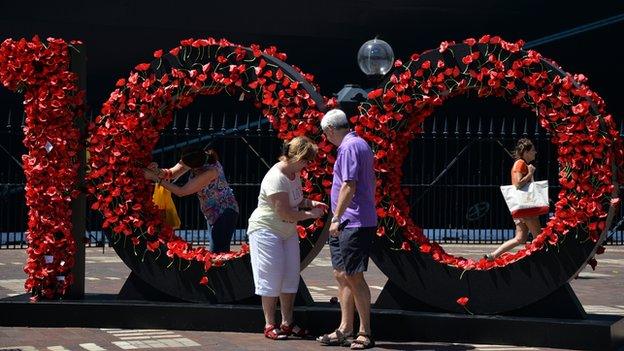
- Published15 April 2015
